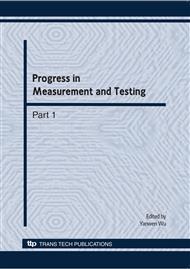[1]
Li Jinfang, YU Xin-wei, Zheng chen Green Chemistry Research and Development Trend [J]. Guangdong Chemical Industry, 2004, 8: 5-7.
Google Scholar
[2]
Qiu Hong, LIU Yan-Qin, Han Shitian. The progress of green chemistry [J]. Hebei Chemical, 2000, 2: 14-16.
Google Scholar
[3]
ZWETSLOOT G I J M, ASHFORD N A. The feasibility of encouraging inherently safer production in industrial firms [J]. Safety Science, 2003, 41: 219 - 2401.
DOI: 10.1016/s0925-7535(02)00003-6
Google Scholar
[4]
Institute of Industrial Economics of Chinese Academy of Social Sciences. 2005 report on China industry development [M]. Beijing: E2 conomy &Management Publishing House , 2005: 2 - 101.
Google Scholar
[5]
Olivier H, Magna L. Ionic liquids: perspectives for organic and catalytic reactions [J]. Journal of Molecular Catalysis A: Chemical, 2002, (182- 183): 419-437.
DOI: 10.1016/s1381-1169(01)00465-4
Google Scholar
[6]
Jen-Ming Chen, Jin-Hua Liu, Jun Tao Hua. Bio-catalysis in green chemistry and drug development application [J]. Chemistry Progress, 2007, 19(12): 1919-(1927).
Google Scholar
[7]
Chen Yi-jun, Wu Rising Sun. Biocatalysis and Drug Research and Development [J]. Chemistry Progress, 2007, 19(12): 1947-(1954).
Google Scholar
[8]
Ming enze, Fu jun. The progress of green chemistry [J]. Chemistry Online, 1999, 1: 10-15.
Google Scholar
[9]
Daniel A. crowl J F L. Chemical Process Safety Fundamentals with Applications[M]. Prentice Hall, (2002).
Google Scholar
[10]
A K T. Cheaper, Safer Plants, or Wealth and Safety at Work[M]. Rugby: IChemE: (1984).
Google Scholar
[11]
A K T. Plant Design for Safety: A User-Friendly Approach[M]. New York: Hemisphere Publishing Corporation, (1991).
Google Scholar
[12]
WU Zongzhi , FAN Xiaohua, YANG Yusheng A review on the study advancements over the relation among inherent safety , cleaner production and green chemistry,Journal of Safety and Environment,2008, 8(4): 135-138.
Google Scholar
[13]
Edwards, D. W., & Lawrence D. Assessing the inherent safety of chemical process routes: Is there a relation between plant costs and inherent safety?[J]. Chemical Engineering Research & Design. 1993, 71(Part B): 252-258.
Google Scholar
[14]
Heikkila A M. Inherent safety in process plant design. An index-based approach[M]. Finland: Technical Research Center of Finland, VTT Publications, (1999).
Google Scholar
[15]
Chidambaram Palaniappan, Rajagopalan Srinivasan R T. Selection of inherently safer process routes: a case study[J]. Chemical Engineering and Processing. 2004, 43: 647-653.
DOI: 10.1016/j.cep.2002.12.001
Google Scholar
[16]
Organisation for Economic Cooperation and Development. OECD environmental health and safety publications series on chemical accidents [M]. Paris: WHO - OMS , 1997 : 23 - 261.
Google Scholar
[17]
EDWARDS D W. Export inherent safety not risk [J ] . Journal of Loss Prevention in the Process Industries, 2005, 18: 254 - 260.
DOI: 10.1016/j.jlp.2005.06.014
Google Scholar
[18]
CORZINE J H C. Chemical Security Act of 2003 [ EB/ OL ] . [2003-09-09] . http: / / www. theorator. com/ bills108/ s1571html.
Google Scholar
[19]
VITO F. Chemical facilities security act of 2003 [ EB/ OL ] . [2003-03-14] . http: / / rwebgate. access. gpo. gov/ cgi2bin/ getdoc. cg2.
Google Scholar
[20]
CLARKJ, LANCASTER M. Green chemistry: the path to a sustainable , competitive chemical industry[J ] . Ziran Zazhi, 2000, 22 (1) : 1 - 61.
Google Scholar
[21]
PALANIAPPAN C, SRINIVASAN R. Selection of inherently safer process routes: a case study [J ] . Chemical Engineering and Processing, 2004, 43 : 647 - 6531.
DOI: 10.1016/j.cep.2002.12.001
Google Scholar
[22]
PALANIAPPA C, SRINIVASAN R , HALIM I. A material centric methodology for developing inherently safer environmentally benign processes [ J ] . Computers and Chemical Engineering, 2002, 15(5): 757 - 7741.
DOI: 10.1016/s0098-1354(01)00786-4
Google Scholar


